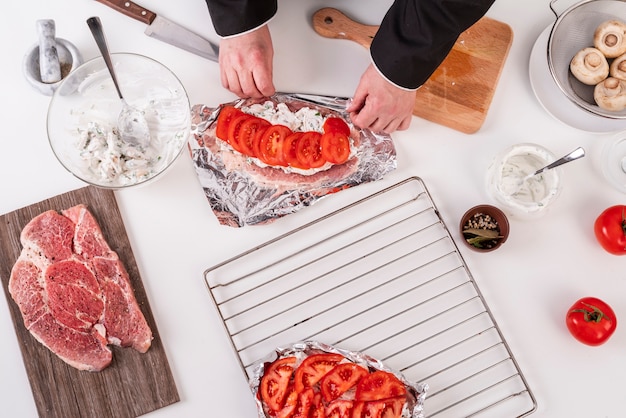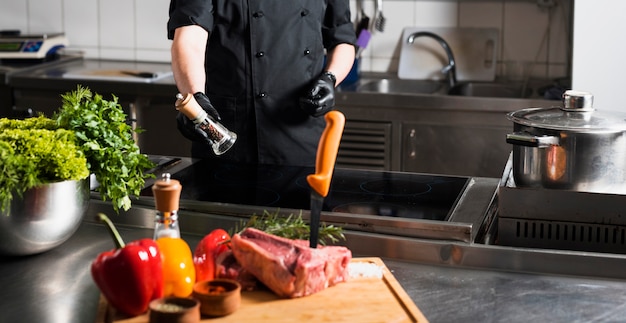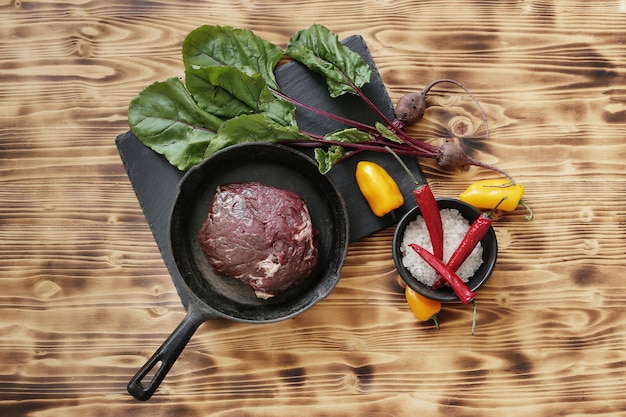Ah, the perfect steak. Just the thought of it sends my taste buds into a frenzy. That beautiful sear, the irresistible aroma, the juicy, tender bite – it’s a culinary experience that’s hard to beat. But let’s be honest, mastering the art of stovetop steak isn’t always a walk in the park. I’ve been there, faced with dry, tough, or just plain disappointing results. But over the years, through countless trials and errors (and a whole lot of delicious experimentation), I’ve learned a few tricks that have transformed my steak game. And that's what this guide is all about – a culmination of those lessons, packed with tips and techniques to help you achieve the ultimate juicy, flavorful steak, every single time. So grab your pan, your favourite steak, and get ready to embark on a culinary adventure with me!
(Part 1) choosing the right steak: A Foundation for Flavor

Imagine a painter standing before a blank canvas, ready to create a masterpiece. The choice of canvas plays a crucial role, just as the choice of steak lays the foundation for a truly remarkable dish. And just like a good artist knows their tools, a skilled cook needs to understand the characteristics of different steak cuts to pick the perfect one for their culinary vision.
The Steak Spectrum: A World of Flavor
There’s a whole world of steak cuts out there, each boasting a unique texture and flavor. For stovetop cooking, I always gravitate towards cuts with a good amount of marbling, which adds richness and tenderness. Think of marbling as the little flecks of fat interspersed throughout the meat, creating a symphony of flavor and juiciness as it melts during cooking. Here are a few of my go-to choices for a truly satisfying stovetop steak:
- new york strip: This classic cut is a true crowd-pleaser, known for its beautiful marbling, juicy texture, and bold flavor. It's a perfect choice for a celebratory steak dinner, where you want to impress your guests with a truly remarkable piece of meat. I love the way the marbling melts into the meat as it cooks, creating a rich, savory sauce that elevates the entire dish.
- Ribeye: If you're looking for buttery flavor and tender texture, Ribeye is your go-to choice. It's often considered the king of steaks, and for good reason. The large amount of marbling in this cut creates a wonderfully juicy and flavorful steak that melts in your mouth. It's a perfect choice for thick, juicy steaks, especially when you want to indulge in a truly luxurious experience.
- filet mignon: For a more delicate flavor, Filet Mignon is a wonderful choice. It’s incredibly tender and has a slightly sweet taste, making it an excellent option for a romantic dinner or a special occasion. It's also a great choice if you prefer a leaner steak, as it has less marbling than other cuts.
- Sirloin: This is a versatile option that offers a good balance of flavor and tenderness, making it perfect for both grilling and pan-searing. It’s a great choice for a quick and easy weeknight meal, but it also holds its own in more elaborate settings. I find that the sirloin steak has a nice firm texture, making it ideal for grilling or pan-searing.
- flank steak: If you're looking for a leaner cut that's perfect for slicing and serving, Flank Steak is a great option. It’s a great choice for fajitas or stir-fries, where you want a flavorful steak that can be thinly sliced and cooked quickly. Flank steak has a unique texture that's a bit chewier than other cuts, but it becomes incredibly tender when sliced against the grain.
Thickness Matters: A Key to Even Cooking
I’ve found that a steak that’s at least 1-inch thick is ideal for stovetop cooking. This thickness allows for a beautiful sear and ensures a juicy, tender interior. A thinner steak will cook too quickly, risking overcooking and drying out. Remember, we want that perfect balance of crisp exterior and juicy interior.
Quality Counts: Investing in Flavor
When it comes to steak, quality really matters. Don’t be afraid to invest in good quality meat. A higher-quality steak will have more natural flavor, cook more evenly, and overall create a more satisfying dining experience. Look for steaks that are well-marbled, have a good color, and feel firm to the touch. You'll be able to taste the difference.
(Part 2) Preparation is Key: Setting the Stage for Success

A great steak starts long before the pan even hits the heat. Think of it like a musician warming up before a concert. Proper preparation sets the stage for a truly harmonious cooking experience.
Bring It To Room Temperature: A Matter of Even Cooking
This is one of my most important tips. Taking the steak out of the refrigerator 30-45 minutes before cooking allows it to warm up to room temperature. This helps it cook more evenly, preventing the inside from becoming too cold while the outside is sizzling. Imagine a cold steak being thrown into a hot pan; the outside sears quickly, while the inside struggles to catch up, resulting in uneven cooking. But a steak that’s at room temperature cooks more uniformly, resulting in a perfectly cooked steak from edge to edge.
Seasoning: The Essence of Flavor
Salt and pepper are your best friends when it comes to steak. Season generously on both sides, ensuring the spices stick to the steak. Don’t be shy, embrace the flavor! I like to add a pinch of garlic powder or onion powder for extra depth and complexity. Experiment with different seasonings and find what works best for your palate. The goal is to create a flavourful crust that complements the natural flavor of the steak.
Pat It Dry: The Secret to a perfect sear
Moisture is the enemy of a good sear. Pat the steak dry with paper towels before cooking. This ensures a crispy exterior and allows for those beautiful grill marks we all crave. The moisture on the surface of the steak will steam rather than sear, preventing the development of that delicious brown crust we all love.
(Part 3) The Sizzling Symphony: A Culinary Performance

Now comes the exciting part - the actual cooking! This is where the pan becomes your stage and the steak, the star of the show. The key is to create a hot, sizzling environment that allows for a perfect sear, ensuring a flavorful crust and a juicy interior.
Cast Iron, My Favorite: A Master of Heat
I’ve always been a big fan of cast iron skillets. They retain heat exceptionally well, ensuring the steak cooks evenly and develops a beautiful crust. But don’t worry if you don’t have one; any heavy-bottomed pan will work. The important thing is to choose a pan that can withstand high heat and distribute it evenly.
High Heat is Essential: A Sizzling Stage
Set your pan over medium-high heat. You want it to be smoking hot. You can test if it’s ready by adding a few drops of water to the pan. If they sizzle and evaporate quickly, it’s time to cook. Remember, a hot pan is crucial for a successful sear, so don’t be afraid to let it get really hot.
Oil it Up: A Lubricating Layer
A thin layer of oil helps create the perfect sear. I use a high-heat oil like avocado oil or grapeseed oil. These oils have a high smoke point, meaning they can withstand high temperatures without breaking down and releasing harmful chemicals.
The Sizzle: A Culinary Transformation
Carefully place the steak in the hot pan. Don’t overcrowd the pan, as this will lower the temperature and prevent a proper sear. Let it cook undisturbed for 2-3 minutes per side, or until a nice crust forms. Resist the urge to move it around; give it time to develop that beautiful, crispy crust. This is where the magic happens – the proteins on the surface of the steak denature, creating that delectable brown crust that seals in the juices and adds a rich, savory flavor.
(Part 4) A Little Bit of Theatre: Creating Grill Marks
Now comes the part that really elevates the experience, adding a touch of culinary drama and visual appeal. We're going to create those beautiful grill marks that scream, "I'm a master chef!”
Rotation is Key: The Art of Grilling
After searing both sides, I like to rotate the steak 90 degrees and sear for another minute. This adds beautiful grill marks and ensures a more evenly cooked steak. Imagine rotating the steak like a compass, allowing each side to develop a perfect sear. This simple step not only enhances the appearance of the steak but also contributes to more even cooking.
The Temperature Game: Doneness Revealed
The final stage of cooking is all about bringing the steak to your desired temperature. Here’s a handy cheat sheet for reference:
| Doneness | internal temperature (°F) | Internal Temperature (°C) |
|---|---|---|
| Rare | 125-130 | 52-54 |
| Medium-Rare | 130-135 | 54-57 |
| Medium | 140-145 | 60-63 |
| Medium-Well | 150-155 | 65-68 |
| Well-Done | 160 | 71 |
Don't Overcook: A Balance of Texture
It’s important to note that the internal temperature of the steak will continue to rise for a few minutes after removing it from the pan. So, it’s always best to err on the side of undercooking. You can always cook it a bit more later, but you can’t undo overcooking. Overcooked steak becomes dry and tough, losing its juicy tenderness.
(Part 5) Rest and Relaxation: A Culinary Pause
After the sizzling symphony, it’s time for the steak to relax. This crucial step allows the juices to redistribute throughout the steak, resulting in a juicier, more tender result. Imagine a steak as a marathon runner; it needs a moment to recover and catch its breath after intense activity.
Ten Minutes of Peace: Restoring Juiciness
Let the steak rest on a cutting board for 10 minutes before slicing and serving. You can cover it loosely with foil to keep it warm. During this resting period, the muscle fibers relax, allowing the juices to redistribute evenly, resulting in a more tender and flavorful steak.
(Part 6) The Finishing Touches: Elevating the Experience
Now comes the fun part – adding those final touches that transform the steak from good to absolutely unforgettable.
Butter: A Touch of Indulgence
I like to add a knob of butter to the pan after removing the steak. As it melts, baste the steak with the flavorful butter. It adds a rich, decadent flavor that's simply irresistible. The butter not only adds flavor but also helps create a beautiful sheen on the steak, enhancing its visual appeal.
Herbs and Spices: A Symphony of Aromas
Fresh herbs like rosemary, thyme, and sage add a beautiful aroma and flavor to the steak. You can also use a blend of peppercorns or a sprinkle of smoked paprika for extra depth. Experiment with different herb combinations to find your favourite flavour profile. A sprinkle of fresh herbs before serving elevates the dish and creates a beautiful presentation.
Garlic: A Classic Pairing
A clove of garlic added to the pan during the last minute of cooking infuses the steak with a lovely garlicky aroma. It adds a subtle yet distinct flavor that complements the richness of the steak beautifully. The heat of the pan releases the aromatic compounds in the garlic, creating a truly delicious experience.
Lemon Juice: A Refreshing Touch
A squeeze of lemon juice can add a bright, acidic touch that cuts through the richness of the steak. It’s a great way to add a refreshing element to the dish. This is especially helpful when pairing steak with rich sauces or heavier sides.
(Part 7) The Perfect Sidekick: Complementary Companions
No steak is complete without a worthy companion. I love to pair my steak with simple, flavorful sides that complement the richness of the meat.
Roasted Vegetables: A Burst of Color and Flavor
Roasted vegetables like Brussels sprouts, asparagus, or broccoli add a beautiful contrast in colour and texture. They also absorb the flavours from the pan, creating a delicious symphony on the plate. Roasted vegetables bring a sweetness and a satisfying earthiness to the dish, creating a balanced and delightful culinary experience.
mashed potatoes: A Comforting Classic
creamy mashed potatoes are a classic pairing for steak. They provide a comforting and satisfying texture that complements the richness of the meat. The creamy texture of mashed potatoes provides a wonderful contrast to the firm texture of the steak, creating a delightful textural experience.
Sautéed Greens: A Touch of Freshness
Simple sautéed greens like spinach, kale, or chard add a touch of freshness and lightness to the plate. They’re also a great way to incorporate extra nutrients. Sautéed greens add a vibrant green color to the plate and offer a lighter, more refreshing element to balance the richness of the steak.
baked potato: A Hearty and Flavorful Option
A baked potato loaded with sour cream, chives, and bacon is a hearty and flavorful accompaniment to steak. It's a classic comfort food combination that's perfect for a satisfying meal.
(Part 8) The Final Word: A culinary journey
Mastering the art of stovetop steak is a journey, not a destination. It takes practice and a willingness to experiment. But with the right techniques, you can achieve those beautiful results that will make your friends and family say, “Wow, that’s the best steak I’ve ever had!”
So embrace the sizzle, enjoy the process, and remember – every steak is a canvas for creating a culinary masterpiece. I hope this guide helps you achieve your steak goals. Happy cooking!
FAQs
1. What's the best way to check if my steak is cooked to my liking?
The best way is to use a meat thermometer. Insert it into the thickest part of the steak, avoiding any bone or fat. Refer to the table in part 4 for the recommended internal temperatures for different levels of doneness. A meat thermometer provides the most accurate and reliable way to ensure your steak is cooked to your desired level of doneness, preventing overcooking and ensuring a juicy, tender steak.
2. What if I don't have a meat thermometer?
You can use the “finger test.” Press the center of the steak. For rare, it will feel soft and jiggly. For medium-rare, it will be slightly firmer. For medium, it will feel firmer still. For medium-well, it will be quite firm. This method is less precise than a thermometer, but it can give you a general idea of the steak's doneness.
3. How do I prevent my steak from getting too dry?
Ensure you don’t overcook the steak. Resting the steak for 10 minutes before slicing also helps retain moisture. Overcooking is the biggest culprit of a dry steak. Using a meat thermometer helps ensure you don't overcook it, and resting allows the juices to redistribute throughout the steak, resulting in a juicier, more tender result.
4. What if my steak is too tough?
The most likely cause of a tough steak is overcooking. Next time, aim to cook it to a lower temperature. You can also try marinating the steak for several hours before cooking to tenderize it. Marinades help break down tough muscle fibers, making the steak more tender.
5. How do I make my steak more flavorful?
Seasoning generously with salt and pepper is essential. Consider adding a pinch of garlic powder or onion powder for extra flavour. Experiment with herbs and spices like rosemary, thyme, sage, or peppercorns. You can also baste the steak with butter, garlic, or lemon juice during the last minute of cooking. Adding a knob of butter to the pan after removing the steak will create a rich, decadent sauce to baste the steak.
Everyone is watching

How to Cook Frozen Lobster Tails Perfectly: A Step-by-Step Guide
RecipesLobster. Just the word conjures up images of lavish meals, special occasions, and a taste of luxury. But let's...

Pigs in a Blanket Cooking Time: How Long to Bake for Perfect Results
RecipesAh, pigs in a blanket. Just the name conjures up images of those delightful little parcels of crispy pastry en...

Pork Fillet Cooking Time: How Long to Cook It Perfectly
RecipesPork fillet, or tenderloin as it's sometimes called, is a real favourite in our house. It's so versatile, and...

The Ultimate Guide to Cooking Delicious Frankfurters
RecipesLet's face it, we all love a good frankfurter. It's a classic, simple, and always satisfying. But let's be rea...

Wolf Meat Recipes: A Guide to Cooking Wild Game
RecipesLet's be honest, you don't see wolf meat at your local butcher shop every day. It's a bit of a wild card, but ...
